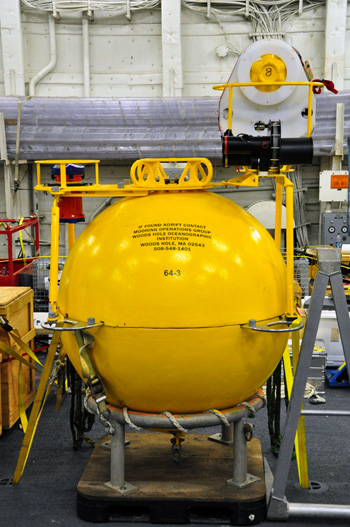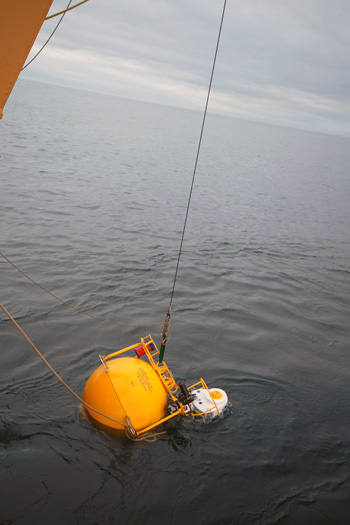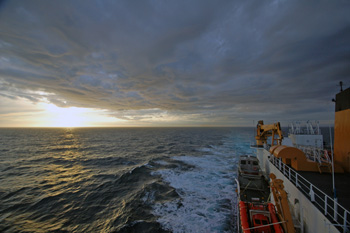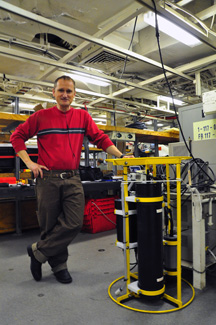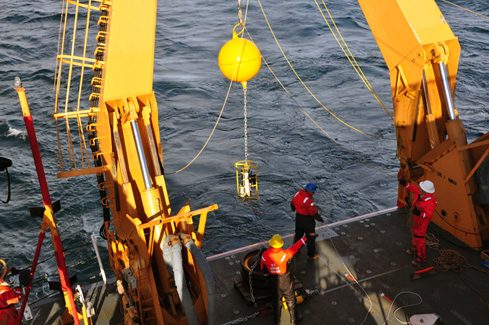September 15thScattered ice floes glinting in the white sunlight materialized out on the horizon this morning about eight miles off. This being an icebreaker, a few patches of it didn’t cause a great stir among the crew or the experienced hands in the science staff. But word spread fast among the rest of us. Squinting from the fantail, peering through binocs from the bridge, we speculated on the size of the larger floes eight miles off by radar. We want ice, and we want to approach the edge of the pack where the action is. I’ve been there before aboard a sailboat in the Greenland Sea, where we saw seals hauled out watching us suspiciously, a sky full of birds, and whales; and I’ve been in the Irminger Sea ice with Dr. Bob—it’s a hard experience to grow tired of. Bob is determined to find a floe large enough to plant a miniature meteorological station to collect data through the winter. We’ll go up to about 74 degrees, our farthest north, where satellite photos show fairly thick ice.
Some people remain confused about the distinction between climate and weather, one of the reasons why the climate discussion has failed to advance beyond squabbling. Suppose we see vast fields of ice 180 miles north of our present position, and we say, what’s all this fuss about the warming? Look, the sea’s full of the stuff. That would be to confuse weather, short-term observation, with climate, which requires long-term measurements, the longer the better, to draw meaningful conclusions. And of course the opposite would be true, if we saw no ice—it’s just one time, one place. Another problem is the dearth of Arctic data. It’s a hard place to work because of the extremes and the ice, the distance from everywhere and the cost. But the region has attracted a lot of multi-disciplinary attention of late because of widespread concern about the warming.
The native populations here and in the eastern Arctic (in the vicinity of Greenland) have long recognized that their climate is changing rapidly, that the ice comes in later every year and goes out earlier, that the patterns of animal behavior have changed as but one result. And scientists respect that there is much to learn about the environment from the natives’ observations, but theirs are “qualitative” observations. Scientists must deal in “quantitative” observations. That is to say, scientists must measure, put numbers to observations, turn them into data in order eventually to get to the why of natural phenomena. One approach is not necessarily better or more sophisticated than the other, just different. However, the scientists tend to be reticent about their hypotheses until they have a satisfactory mass of support data. And even then there is always the looming possibility that some new data might be discovered to contradict their conclusions. That’s why the “theory” is the highest level of certainty in science. Scientists are natural skeptics. But because scientists are reticent, the climate-change naysayers have found an exploitable opening for their propaganda—and others a way to say, for instance, well, evolution is just a theory. On Deck Because the weather has been fair and the technicians highly skilled, mooring operations are almost complete. They have deployed eight moorings of various sorts and “turned around” several others. Turnaround means that they have retrieved the moorings, extracted the stored information, installed fresh batteries, and put them back in the water. Bob’s big mooring was retrieved yesterday, but the Arctic winch was missing. He wasn’t particularly surprised; it travels in a very dangerous neighborhood, and he’s lost others on previous cruises. But he was pleased to find that before it’s demise, it had recorded data about that upper layer through June, eleven full months of data. They’re installing a replacement winch and re-deploying it later today. The new generation of Arctic winch, still in development, will contain a sonar device to warn and stop it while it’s still a safe distance from the bottom of the ice. Ocean Breath “What I’m interested in is learning about how the ocean breathes,” said Craig, from the Applied Physics Lab. Yesterday, much to his delight, Craig deployed a pod of instruments on a mooring to measure the uptake of carbon dioxide, among other dissolved gasses, by the ocean. The ocean has been doing us a big favor by absorbing one-third of the CO-2, a major greenhouse gas, we’ve been emitting for centuries. Of the other two-thirds, one is absorbed by the biosphere (mainly terrestrial plants). The final third remains in the atmosphere. That third absorbed by the ocean, however, must first enter the atmosphere, the ocean’s sibling fluid. Therefore, Craig is measuring the carbon-cycle exchange between ocean and atmosphere. “What I’m interested in is learning about how the ocean breathes” -Craig McNeil But the Arctic is special—again, because of ice. Ice acts as a cap in winter nearly halting the air/sea exchange, but when the ice retreats in summer and sun shines on the water, those great blooms of phytoplankton appear. Acting just like terrestrial plants, phytoplankton absorb CO-2 and release oxygen. But when the plankton die and settle on the seafloor to be consumed by bacteria, that CO-2 is re-released into the ocean. That’s a skeletal explanation of the carbon cycle; its mechanics are known. But how does the process work quantitatively in the Arctic? What exactly goes on in the seasonal transitions between ice-in and ice-out? What will happen when the annual quantity of sea ice diminishes? How does the ocean breathe in the ice zone? No one knows because there have never been any long-term, direct measurements of CO-2 (or oxygen, nitrogen, and methane) in the Arctic. That’s what makes Craig’s prototype work important.
The ocean will continue to exchange CO-2 and other gasses with the atmosphere, no matter what happens. It will continue to breathe whether or not the ice disappears. The ocean and atmosphere abide in the long term, but we live in the short term, where changes matter. And scientists are beginning to understand that the ocean’s capacity to contain the “extra” CO-2 we’re dumping into it is finite. Evidence—including coral reef bleaching—seems to suggest that we’ve filled up the ocean with the result that CO-2 and seawater combine to form carbonic acid. Nature will go about its dynamic business, but we might not like the resulting conditions on land or sea. Last updated: September 28, 2010 | |||||||||||||||||||||||
Copyright ©2007 Woods Hole Oceanographic Institution, All Rights Reserved, Privacy Policy. | |||||||||||||||||||||||
